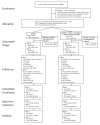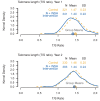Effects of water, sanitation, handwashing, and nutritional interventions on telomere length among children in a cluster-randomized controlled trial in rural Bangladesh
- PMID: 28980942
- PMCID: PMC5675593
- DOI: 10.7554/eLife.29365
Effects of water, sanitation, handwashing, and nutritional interventions on telomere length among children in a cluster-randomized controlled trial in rural Bangladesh
Abstract
Background: Shorter childhood telomere length (TL) and more rapid TL attrition are widely regarded as manifestations of stress. However, the potential effects of health interventions on child TL are unknown. We hypothesized that a water, sanitation, handwashing (WSH), and nutritional intervention would slow TL attrition during the first two years of life.
Methods: In a trial in rural Bangladesh, we randomized geographical clusters of pregnant women into individual water treatment, sanitation, handwashing, nutrition, combined WSH, combined nutrition plus WSH (N + WSH), or control arms. We conducted a substudy enrolling children from the control arm and the N + WSH intervention arm. Participants and outcome assessors were not masked; analyses were masked. Relative TL was measured at 1 and 2 years after intervention, and the change in relative TL was reported. Analysis was intention-to-treat.
Results: Between May 2012 and July 2013, in the overall trial, we randomized 720 geographical clusters of 5551 pregnant women to a control or an intervention arm. In this substudy, after 1 year of intervention, we assessed a total of 662 children (341 intervention and 321 control) and 713 children after 2 years of intervention (383 intervention and 330 control). Children in the intervention arm had significantly shorter relative TL compared with controls after 1 year of intervention (difference −163 base pairs (bp), p=0.001). Between years 1 and 2, TL increased in the intervention arm (+76 bp) and decreased in the controls (−23 bp) (p=0.050). After 2 years, there was no difference between the arms (p=0.305).
Conclusions: Our unexpected finding of increased telomere attrition during the first year of life in the intervention group suggests that rapid telomere attrition during this critical period could reflect the improved growth in the intervention group, rather than accumulated stress.
Funding: Funded by The Bill and Melinda Gates Foundation.
Clinical trial number: NCT01590095.
Keywords: child intervention; epidemiology; global health; human; low-income; nutrition; randomized controlled trial; telomere length; water, sanitation, hygiene.
Plain language summary
Stress negatively affects health by causing changes in cells. As a result, excess stress may predispose people to fall ill more often or age faster. It is difficult to measure stress. Some studies suggest that measuring the ends of chromosomes, known as telomeres, may be one way to measure stress. Like the plastic tips on shoelaces, telomeres protect chromosomes from fraying. All peoples’ telomeres shorten over their lifetime with each cell division. Many studies show that telomeres shorten faster in people who experience more stress. When telomeres become too short, cells die faster without being replaced, and the body ages. Most studies on telomere length have looked at adults. Few studies have looked at children early in life or asked whether there are ways to intervene to stop or reverse stress-related telomere shortening. The first two years of life are a crucial period for the developing brain and immune system, which could set children on a lifelong course toward health or disease. Young children living in low-resource settings often encounter many sources of stress, like poor nutrition, infectious diseases or violence. Studies are needed to determine if interventions in early childhood aimed at reducing some sources of stress improve telomere length or long-term health. Now, Lin et al. show that interventions to provide safe water, sanitation, handwashing facilities, and better nutrition to children in rural Bangladesh unexpectedly shortened telomeres. As part of a larger study, pregnant women in rural Bangladesh were divided, at random, into groups. One group received a suite of interventions, which included more sanitary toilets, handwashing facilities, and nutritional supplements for their infants. Another group served as a control and did not receive this extra help. Lin et al. looked at telomere length, growth, and infections in a subset of 713 children whose mothers participated in the study. Children who got the extra help grew faster and were less likely to get diarrhea or parasitic infections than the children in the control group. Unexpectedly, children in the intervention group had shorter telomeres at 14 months of age than the children in the control group. Lin et al. suggest that the telomere shortening in the intervention group might be a consequence of rapid growth and immune system development in the first year of life rather than resulting from biological stress. More studies are needed to ask whether telomere shortening is indeed linked to faster growth and development early in life. The strong and unexpected findings highlight how little is known about how the length of telomeres can be used to predict future health or disease. Interpreting the length of telomeres over a person’s lifetime could prove more nuanced than originally thought.
Conflict of interest statement
No competing interests declared.
Co-founder of Telomere Diagnostics Inc., a telomere measurement company.
Figures



References
-
- Arnold BF, Null C, Luby SP, Unicomb L, Stewart CP, Dewey KG, Ahmed T, Ashraf S, Christensen G, Clasen T, Dentz HN, Fernald LC, Haque R, Hubbard AE, Kariger P, Leontsini E, Lin A, Njenga SM, Pickering AJ, Ram PK, Tofail F, Winch PJ, Colford JM. Cluster-randomised controlled trials of individual and combined water, sanitation, hygiene and nutritional interventions in rural Bangladesh and Kenya: the WASH Benefits study design and rationale. BMJ Open. 2013;3:e003476. doi: 10.1136/bmjopen-2013-003476. - DOI - PMC - PubMed
-
- Black MM, Walker SP, Fernald LCH, Andersen CT, DiGirolamo AM, Lu C, McCoy DC, Fink G, Shawar YR, Shiffman J, Devercelli AE, Wodon QT, Vargas-Barón E, Grantham-McGregor S, Lancet Early Childhood Development Series Steering Committee Early childhood development coming of age: science through the life course. The Lancet. 2017;389:77–90. doi: 10.1016/S0140-6736(16)31389-7. - DOI - PMC - PubMed
Publication types
MeSH terms
Associated data
LinkOut - more resources
Full Text Sources
Other Literature Sources
Medical
Research Materials

